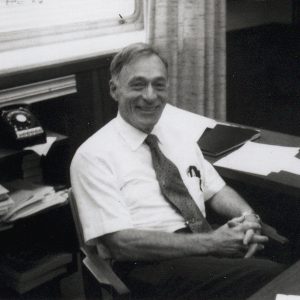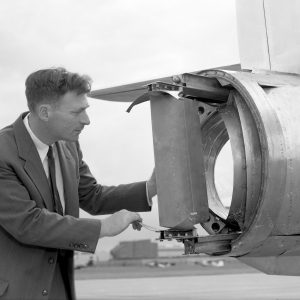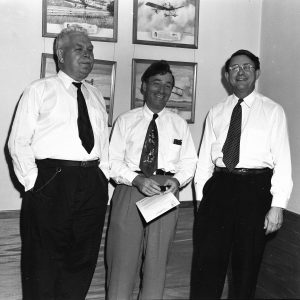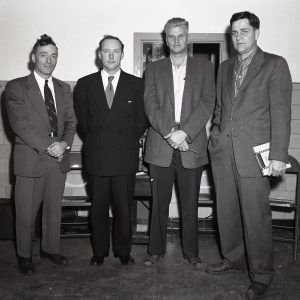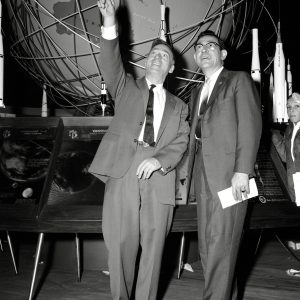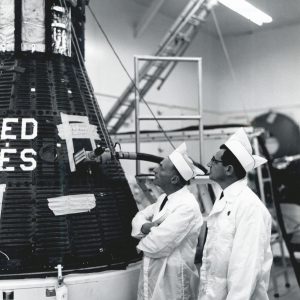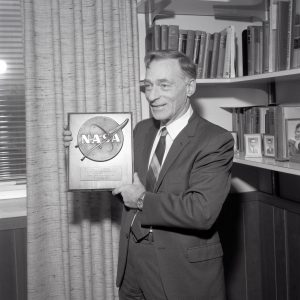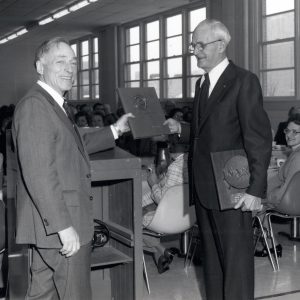I. Irving Pinkel
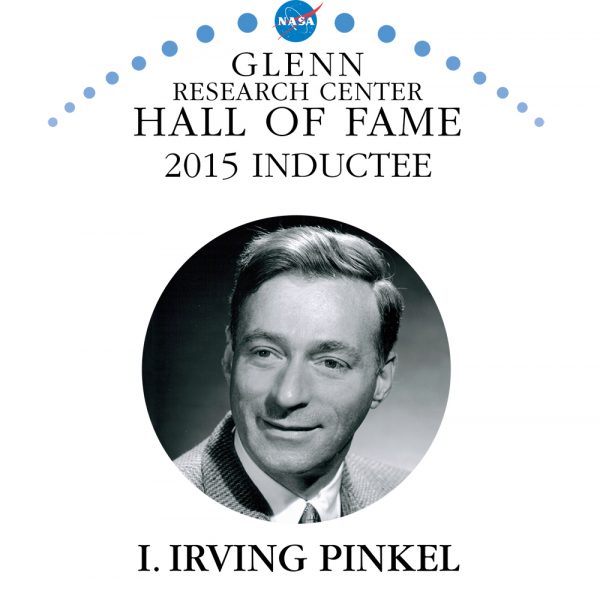
Biography
I. Irving Pinkel was an authoritative voice of aerospace safety not only at the laboratory that today is the NASA Glenn Research Center, but across the agency and industry. Although he was involved in a wide array of aircraft operational issues, it was the massive Crash Fire Test program from 1948 to 1957 that made Pinkel a preeminent figure in aircraft accident investigations. The program determined how fires spread and how loads were distributed in crashes, and it led to Pinkel’s patents for an extinguishing system and a crash-resistant seat. Pinkel’s expertise was repeatedly called upon over the years, including for investigations into the Apollo 1 fire and the Apollo 13 accident. He remained active with aerospace safety issues long after his retirement in 1974.
Pinkel was born in Gloversville, New York, and earned his bachelor’s degree in physics from the University of Pennsylvania in 1934. After completing several graduate classes, he accepted a position with the Bureau of Mines in Pennsylvania. In 1940 Pinkel joined the staff at the National Advisory Committee for Aeronautics’ (NACA’s) Langley Memorial Laboratory, where his older brother Benjamin was a power plants engineer. He spent 2 years studying the effects of flutter on wings. In 1942, both Pinkel brothers transferred to Cleveland, Ohio, when the NACA opened its Aircraft Engine Research Laboratory.
During the war, Irving Pinkel concentrated his efforts on hydraulics lubrication and oil systems for high-altitude aircraft. He developed and patented a mechanism that used electric condenser plates to prevent oil aeration. Pinkel was named group leader for the Wind Tunnel Analysis Panel in 1945. After the war, he contributed to the Lab’s continuing education by presenting several lectures on fluid mechanics.
Pinkel was also drawn into the new fields of turbojet engines and high-speed flight, particularly supersonic flow through compressors. Despite the increase in his other duties over the years, he continued to study supersonic flight and perform theoretical nozzle and compressor research. Pinkel determined that the burning of fuel under the wing would produce heat to provide lift and thrust during supersonic flight. These accomplishments, however, would soon be overshadowed by Pinkel’s achievements in flight safety.
Pinkel was assigned to the icing research program in the mid-1940s. He worked with the researchers to change the engineering-based program into one involving scientific analysis. The group not only evaluated deicing systems but undertook a multiyear effort to study the composition of ice-producing clouds. In 1949 Pinkel was named associate Chief of the Physics Division. In this role, he investigated slippery runways, lightning strikes to aircraft, and the jettisoning of fuel in flight. During this period, Pinkel was a member of NACA subcommittees on fire prevention, icing problems, flight meteorology, and operating problems. He also was a member of the Federal Aviation Administration’s (FAA’s) Committee on Lightning Hazards to Aircraft.
The postwar years had brought a dramatic increase in airline travel, but by 1947, an increasing number of fatal crashes threatened to damage the industry’s gains. President Eisenhower called upon the Civil Aeronautics Authority (CAA, the FAA’s predecessor) to immediately investigate airline safety. NACA’s lab in Cleveland formulated a plan to carry out this study by systematically crashing excess transport aircraft in order to study the behavior of postcrash fires and determine proper interventions.
In 1949, Irving Pinkel was asked to personally supervise the Crash Fire Test program. The first phase identified fuel disbursement, ignition sources, and combustible materials. The group developed an inerting system to cool ignition points and extinguish fires within the engine upon impact. The next phase examined the forces imposed on both the aircraft and its passengers during a crash. Pinkel and his team provided guidelines for better overall aircraft design and developed a flexible crash-resistant seat that greatly minimized the forces on the occupants. The final phase of the testing involved jet aircraft, which had different causes and remedies than those of the reciprocating engines studied earlier.
Pinkel and his team were lauded throughout the agency and abroad for the crash-related research. He received the Flight Safety Foundation Award (1953), Laura Tabor Barbour Air Safety Award (1956), the NACA Distinguished Service Medal (1957), and the NASA Sustained Superior Performance Award (1963). Almost all of the other key members of the Crash Fire Test team went on to play key roles in Project Mercury and the Apollo program.
Pinkel’s group also tackled a number of other difficult aeronautic problems—including lubrication, wear, noise reduction, and using liquid-hydrogen propellant to operate a B–57 Canberra. In 1960 Pinkel participated in the military’s accident investigations of the B–58 Hustler, the first supersonic bomber.
As the laboratory became part of NASA in 1958, Pinkel was named chief of the new Fluids Systems Components Division. This group was critical to the development of systems to pump and store the cryogenic propellants that would power NASA’s upper-stage rockets, including Saturn, Centaur, and the Nuclear Engine for Rocket Vehicle Application (NERVA). In 1960 Pinkel participated in the NASA Review Team that appraised General Dynamics’ new Centaur rocket. In 1963 he was asked to participate in the design review of the Kiwi-B-2A reactor for the NERVA program.
NASA called upon Pinkel’s crash fire experience following the deadly Apollo 204 (renamed Apollo 1) fire in January 1967. Within days Pinkel arrived at the NASA Kennedy Space Center to help inspect the damaged capsule, develop a timeline of events, and offer insight into the origin and propagation of the fire. Pinkel spent over a year helping with the redesign of the Apollo capsule and spacesuits.
Following the investigation, NASA Administrator James Webb asked Pinkel to serve as director of the new NASA Aerospace Safety Research and Data Institute (ASRDI) being established at the NASA Lewis Research Center in Cleveland. ASRDI collected information regarding all of NASA’s safety problems into a single dynamic database accessible to the entire agency. Pinkel authored papers on safety issues for engineers to consider while designing the space shuttle, and he led an investigation into the crash of the center’s F–8 Crusader in July 1969. While in this position, Pinkel was summoned as an official observer to the review board for the Apollo 13 incident in April 1970. Board Chairman Edgar Cortright thanked Pinkel afterwards, “It was a long and concentrated effort and required a considerable personal sacrifice on your part to be so long away from home and office. However, your dedicated participation was instrumental in bringing our work to a satisfactory conclusion in a relatively brief time span.”
Pinkel retired 2 years later in 1972 after 32 years of NACA and NASA service. He remained active in retirement as a consultant for national laboratories and the aerospace industry, and he frequently participated in airline crash investigations. At the age of 95, Irving Pinkel passed away on March 13, 2008.
Documents
- Irving Pinkel Biographical Sketch (1972)
- Pinkel Newspaper Articles (1953-82)
- Pinkel Newsletter Articles (1944-58)
- Pinkel Newsletter Articles (1960-2008)
- Awarded Distinguished Service Medal (1957)
- Named Aerospace Safety Research Director (1968)
- Photographs of Irving Pinkel Awards

